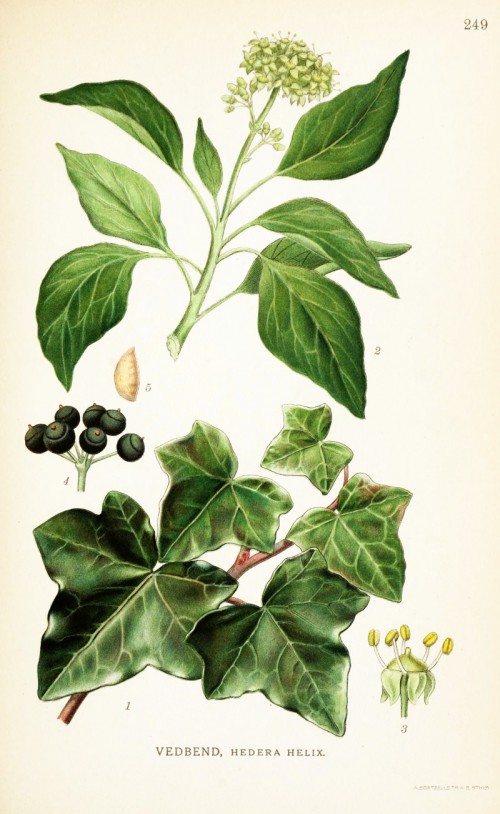Benutzer-Werkzeuge
Dies ist eine alte Version des Dokuments!
Hedera helix L. - Araliaceae - common ivy, English ivy, (Gemeiner) Efeu
Evergreen woody climber, native to Europe, the Mediterranean, and West Asia, widely cultivated as an ornamental; leaves alternate, simple, ovate (on creeping and climbing stems) to palmately five-lobed (flowering stems exposed to full sun); flowers yellow.
Extracts of leaves are used in bronchial diseases, including spasmodic cough. The extract has expectorant and antispasmodic properties. Higher doses may be irritant to mucosa and skin.
[http://de.wikipedia.org/wiki/Gemeiner_Efeu]
„The leaves can cause severe contact dermatitis in some people. People who have this allergy (strictly a Type IV hypersensitivity) are also likely to react to carrots and other members of the Apiaceae as they contain the same allergen, falcarinol.“
http://en.wikipedia.org/wiki/Hedera_helix
„Phytochemical analysis of ivy can comprise a wide range of compounds such as bidesmodic triterpene saponines (e.g.hederacoside C, α-hederine), volatile oil (e.g. methylethylketone), polyines (e.g. falcarinol), steroids (e.g. β-sitosterol), phenols (e.g. rosmarinic acid), and flavonoids (e.g. rutin)…
α-Hederin amounts in younger flowering branch leaves were remarkably higher than in older ones, in B2, [it] was found in 1.62% whereas in B1 it was only 0.18%. Non-flowering branch leaves (B3) contained hederacoside C in 6.53%, which was found in flowering branch leaves (B1) in 4.72% amount, α-hederin was not detected in B3.“
[HPLC profiling and quantification of active principles in leaves of Hedera helix L., Demirci, B., Goppel, M., Demirci, F., Franz, G., Die Pharmazie - An International Journal of Pharmaceutical Sciences, Vol.59(10), 2004, 770-774]
„Common ivy contains up to 10% saponins such as α- and β-hederin. Hederin is a strong irritant to the mucosal surfaces of the nose and throat. As mentioned above, the polyacetylenic compounds falcarinol and didehydrofalcarinol detected in stalks, leaves, and roots of common ivy may cause both irritant and allergic contact dermatitis. The leaves commonly contain more than 1% of the sensitizer which explains the risk of developing irritant contact dermatitis…
During a 16-year period from May 1993 to May 2009, 127 persons, including controls, were patch tested with falcarinol and 10 tested positive.“
[Dermatitis from common ivy (Hedera helix L. subsp. helix) in Europe: past, present, and future., Paulsen, E., Christensen, L.P., Andersen, K.E., Contact dermatitis, Vol.62(4), 2010, 201-209]
Oral administration of hederacoside C to rats results in a low absolute oral bioavailability of 0.118–0.250%. This extremely bioavailabilty may be due to poor absorption from the gastrointestinal tract and/or its decomposition therein.
[Pharmacokinetics of hederacoside C, an active ingredient in AG NPP709, in rats., Kim, J.M., Yoon, J.N., Jung, J.W., Choi, H.D., Shin, Y.J., Han, C.K., Kang, H.E., Xenobiotica, Vol.43(11), 2013, 985-992]
The ethanolic extract was tested for its antiinflammatory properties on rat paw edema. „Intraperitoneal injections of 7.5 ml/kg wt ethanol extract showed antiinflammatory activity with 88.89% inhibition as compared to reference drug diclofenac, which showed 94.44% inhibition in formalin-induced paw oedema.“
[The antiinflammatory and antiarthritic properties of ethanol extract of Hedera helix., Rai, A., Indian journal of pharmaceutical sciences, Vol.75(1), 2013, 99]
http://www.ncbi.nlm.nih.gov/pmc/articles/PMC3719157/
„The effect of ivy leaves dry extract is based on its secretolytical and broncholytical properties. The main active compounds are saponins (Cioacá et al., 1978, Trute et al., 1997 and Bedir et al., 2000), especially alpha-hederin represents the most important saponin molecule responsible for the therapeutic effect (Sieben et al. 2009). Alpha-hederin inhibits the internalization of the β2-receptor leading to an increased adrenergic accessibility of the cells. Subsequently, type II alveolar epithelial cells generate more surfactant yielding to the secretolytic activity by reduction of the mucus viscosity. Similarly, the bronchodilating effect can be related to the increased β2-adrenergic activity resulting in a higher sensitivity to spasmolytics such as adrenalin, the strongest physiological bronchodilator (Hegener et al. 2004). In a double blind comparative study against Ambroxol, the ivy leaves dry extract demonstrated non-inferiority concerning relevant clinical and lung function outcome parameters (Meyer-Wegener et al. 1993).
… children with mild uncontrolled asthma despite regular inhaled corticosteroid therapy might benefit from an additional therapy with ivy leaves dry extract. However, further studies are needed.“
[Tolerance and effect of an add-on treatment with a cough medicine containing ivy leaves dry extract on lung function in children with bronchial asthma., Zeil, S., Schwanebeck, U., Vogelberg, C., Phytomedicine, Vol.21(10), 2014, 1216-1220]
http://www.sciencedirect.com/science/article/pii/S094471131400227X

Lindman, C.A.M., Bilder ur Nordens Flora, vol.2, t.249 (1922-1926)
http://plantgenera.org/species.php?id_species=496846

